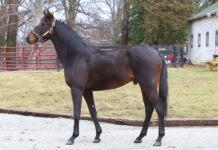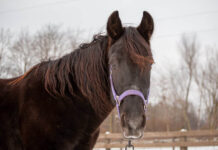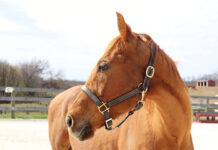
around them and react accordingly, so first impressions are important. Give your new horse the
best possible homecoming experience by slowly acclimating him to his surroundings.
Nicholasville, Ky., advises giving a rescue horse one to two weeks to get adjusted to his new
home before delving into the routine you’ve planned for him. “Introduce your horse to his new
environment and to other horses,” she says. “Maybe walk him around the farm. Let him settle in
slowly before you start to do anything with him.”
Accommodations
Whether you decide to board your new adoptee or keep him at home, there are bound to be some
changes to his living arrangements. Because most of the horses at the KyEHC live outside in
large pastures year-round, getting accustomed to spending more time in a stall may be part of
the acclimation process. This was particularly true for a mule named John Boy; Captain, a
Thoroughbred gelding; and McKinsey, a Paint mare, who were adopted by Joyce Brinsfield, a
horse trainer at a boarding and training farm in Versailles, Ky. “We didn’t put them out right
away,” she says. “We just got them used to being around here. It’s a lot different because
there’s a lot going on compared to a private farm.
“They adapted [to the stalls] pretty quickly,” continues Brinsfield. “They like being in
the barn because of the attention they get.”
On the other hand, Emily Brooks, a surgery technician at Rood and Riddle Equine Hospital in
Lexington, Ky., turned out Marina King—a 5-year-old Thoroughbred gelding that she adopted as a
buddy for her other horse—right away.
“I turned him out by himself in a paddock,” says Brooks. “I wanted to see him move, and see
how he would interact with his neighbors in the other pasture. He just started grazing and
seemed really relaxed so I left him out for a couple of days.”
How you familiarize your adoptee to his new lifestyle will depend on his personality and
your facilities. The process may take some trial and error, so be responsible and monitor your
horse to be sure the situation is not causing him stress.
Meet and Greet
If you already have horses at home or are moving your adoptee into a boarding facility, he
will eventually have to interact with his new barnmates. Your horse’s disposition and the
pasture layout will dictate the appropriate way to do this. When Brinsfield felt her new trio
was ready to interact with the other horses at the stables, she placed them with older,
experienced lesson horses and separated them by gender. Since her paddocks are small, there
are generally only three horses in each.
Supervision is essential to be sure horses are able to safely coexist. Elaine Asher, who
has been a horse owner for 20 years, kept a very close watch on her new adoptees: Smokehouse
Charlie and Attune, 3-year-old off-the-track Thoroughbred geldings; and Jamaican Jake, a
4-year-old Thoroughbred gelding who was trained for the track but never raced. “We have a
small paddock, and I let them all out there first to see how they would react to each other.
Since there was no biting, I let them into a larger pasture. I was out there a lot to make
sure they were getting along.”
Anna Whites, a horse owner in Frankfort, Ky., boards her adoptee, Carli, a 3-year-old
off-the-track Thoroughbred mare. Due to an injury, Carli was on stall rest and limited turnout
for the first two months that she was with Whites. When Carli was approved for turnout, Whites
introduced her to the other horses by walking her around the outside of the pastures. “When
she could be walked, we hand-walked her and let her sniff over the fence. Then they turned her
out with their quietest mare, and put two geldings in with them later.”
Brooks gave her two horses the opportunity to safely interact with each other over a fence
before she turned them out together. “I have two pastures that are blocked off by a gate, but
they can see each other [over the fence] and got used to each other that way,” she says.
“After Marina King had been out alone for three or four days, I turned them out together. I
kept my eye on them for the first couple of hours, but they settled down right away,” adds
Brooks, noting that introducing horses to each other should be done gradually.
History Mystery
When it comes time to get your new horse into a routine, knowing where to start can be
difficult because rescues such as the KyEHC generally don’t receive much background
information about the horses they take in. The most difficult issue for Brinsfield was
learning what her equines did and didn’t know. “You can’t judge them from what a piece of
paper says. [You won’t know what] they know until you handle them and figure it out.”
Brooks also didn’t know much about Marina King, but she found that patience and working
with him slowly was the best way to approach the situation. “I tried to do a little bit at a
time,” she says. “I left him out for a couple of days, and then I brought him in and started
grooming him and tacking him up to see how he would do, and how he was on the cross-ties. I
gave him about two weeks before I got on him, and then I started really slow because I hadn’t
even seen him trot.” Brooks now competes Marina King at Training level in eventing.
Asher was cautious but very hands-on with her horses. “I was more careful about walking
behind them and reaching up toward [their heads],” she says. “I spent a lot of time touching
their ears and stomachs because sometimes they’re touchy about it. I groomed them and picked
their feet every day. I wanted them to be comfortable with me and their surroundings.”
Training and Skills
Not knowing a horse’s background will also affect your knowledge of any training issues. The
KyEHC staff does what they can to evaluate each horse’s ground manners and riding skills, but
they don’t have the resources to fully assess and retrain any of the horses.
Like Brinsfield, you may have to start with basics. “McKinsey had only been trail ridden,
so she had to learn to pick up her leads,” she says. “It was the same thing with Captain
because he was broke for the track, so I started him from square one. I just keep riding them
to get them used to it and don’t make a big fight out of anything.”
Sometimes fear can be the root of problems regarding training and behavior, which Asher
discovered when working with Jake. “He was spooky and scared to death of fly spray and being
groomed,” says Asher. “I spent a lot of time with him in the stall. He would let me brush him
as long as I didn’t go near his head, and he would quiver when I touched him with the brush. I
just talked to him and patted him a lot.” She says time and patience are the keys to her
interaction with Jake.
Asher was also faced with an issue that is common among young horses: Charlie didn’t have
an understanding of lifting his feet so they could be cleaned and trimmed. “Every morning and
evening, I was concerned about picking and cleaning his feet, and my husband would hold
[Charlie’s feet] up like the farrier does. He held them a little longer each time to get
Charlie used to it.”
Whites’ horse, Carli, was sensitive about being brushed and would kick, bite or rear when
something startled her. “I would just take a blanket, a tarp or a garbage bag and rub her all
over,” says Whites. “She’s very food-oriented, so every time I show her something new, I put a
piece of apple on it. When she gets over the excitement, she knows all new things come with
food.”
When adopting a horse, look for one that matches your horsemanship skills. If you’re not
experienced in working with off-the-track Thoroughbreds, you should not adopt one.
Nip it in the Bud
If you find that your new horse has behavior issues, it’s important to begin correcting them
immediately. If you are unsure of the proper way to do this, seek the help of a professional
horse person.
Biting is a frequent problem among young horses that haven’t learned appropriate ground
manners or don’t understand who’s boss in the human-horse relationship. Asher had to find a
way to assert herself when Charlie started nipping. “Any time Charlie would turn his mouth
toward me, I just pushed his head away,” she says, adding that she made a harsh sound to
fortify her rebuke of Charlie’s behavior.
Whites’ horse, Carli, exhibited a severe biting problem. “She bit very hard and very
often,” says Whites. “She would bite when I groomed her and when I cinched her.” To put an end
to Carli’s misbehavior, Whites says she waved her arms in the air and yelled “no.”
Learning from Experience
Remember to introduce your adoptee to his new life gradually, and don’t overload him with too
many experiences at once. As Whites points out, you may have to start from scratch. Don’t
assume that your horse knows something. Brooks says it’s also crucial to be patient and to not
give up.
“It’s easy to get frustrated, but if you give it enough time, you’ll see that it’s
definitely worth it,” says Brooks. “It’s exciting to see [a horse] learn.”
Asher adds a word of caution: “Be aware that you don’t know for sure any of your horse’s
behavior habits,” she says. “Be cautious with whatever you’re doing—when you go into the stall
and when you groom.”
Adopting a horse is a big responsibility, and one you should take on only if you are
prepared and experienced. If you are still new to the horse world, you should always work with
a professional at your side.
Back to Diary of a Horse Rescue
This article originally appeared in the November 2009 issue of Horse Illustrated. Click here to subscribe.






